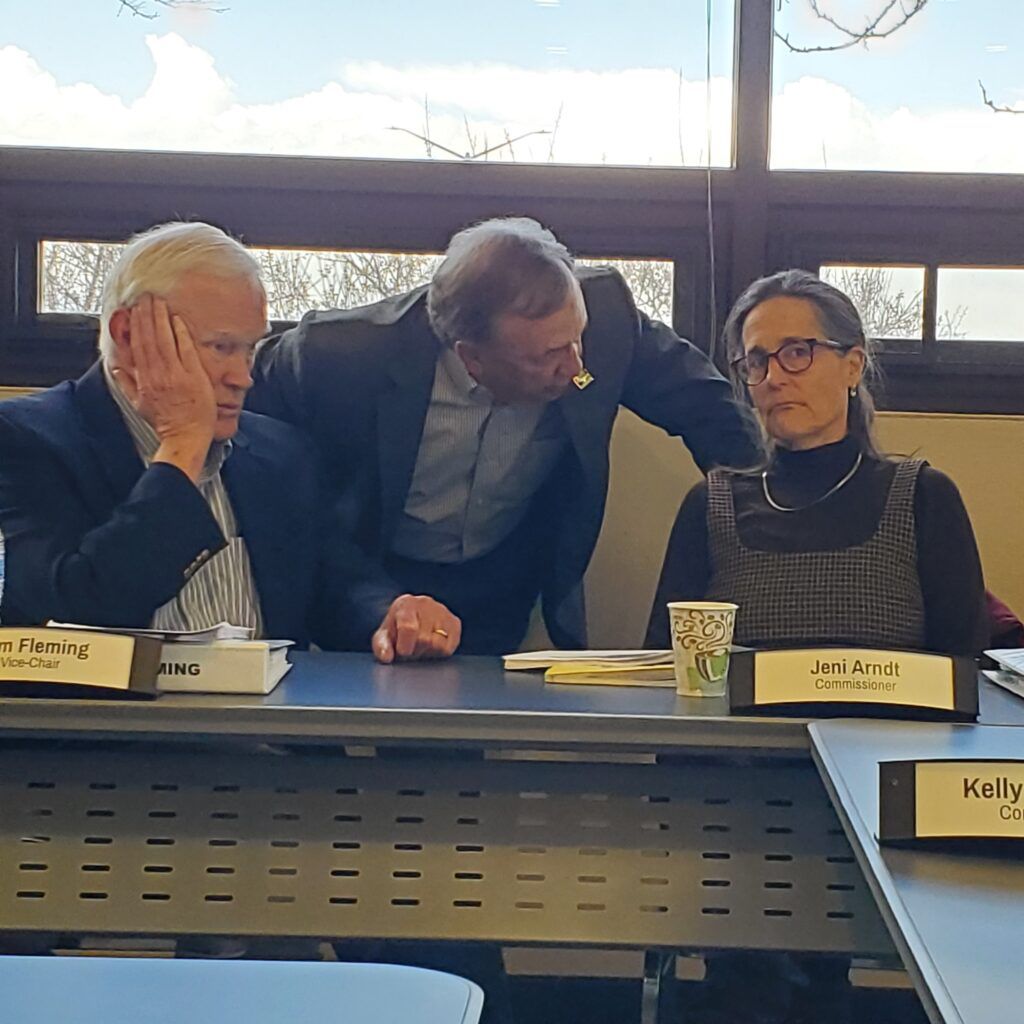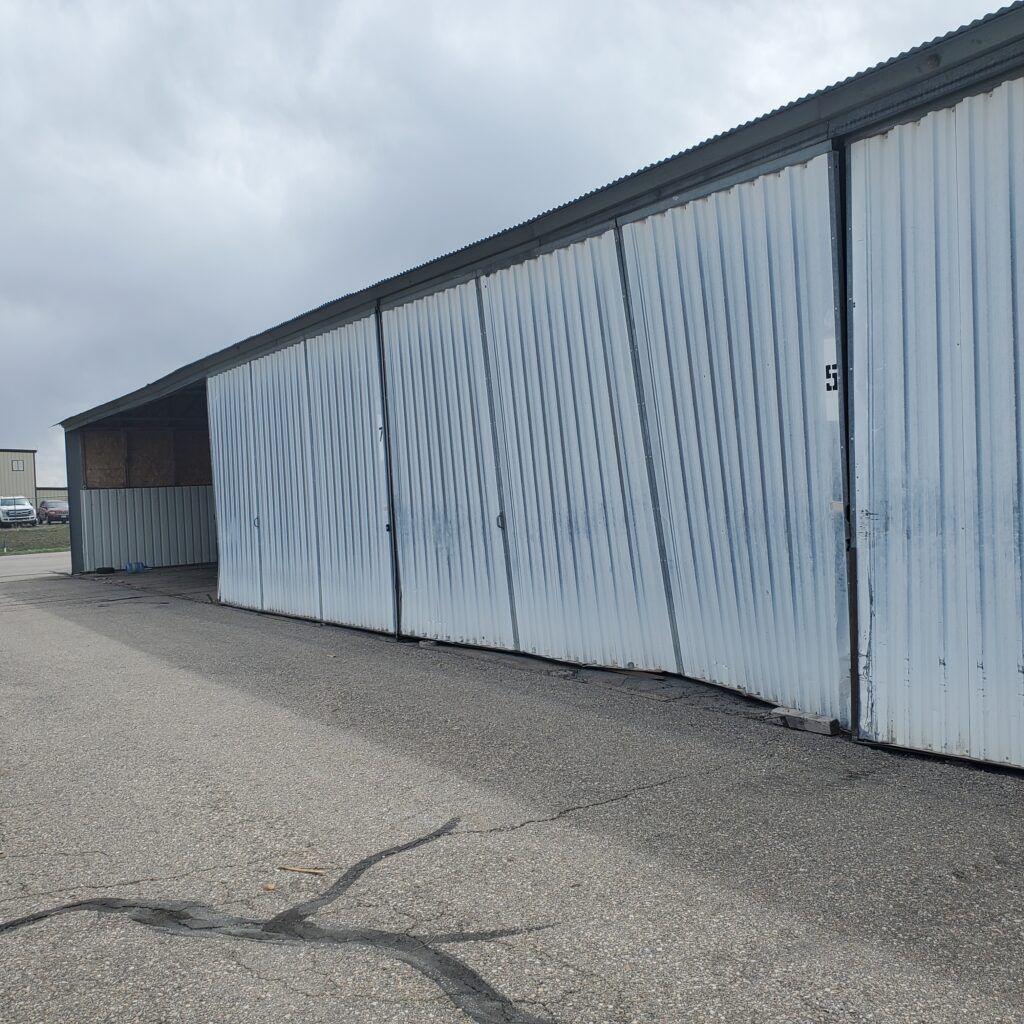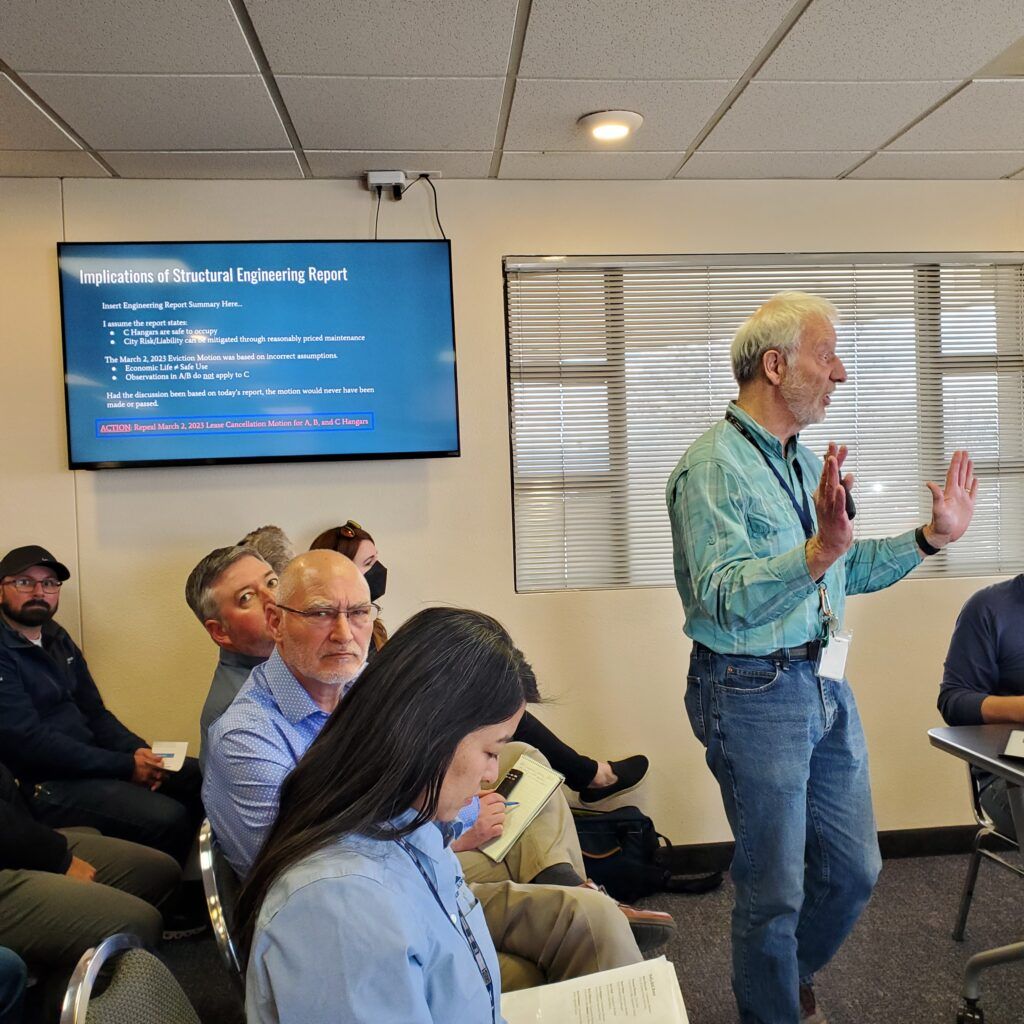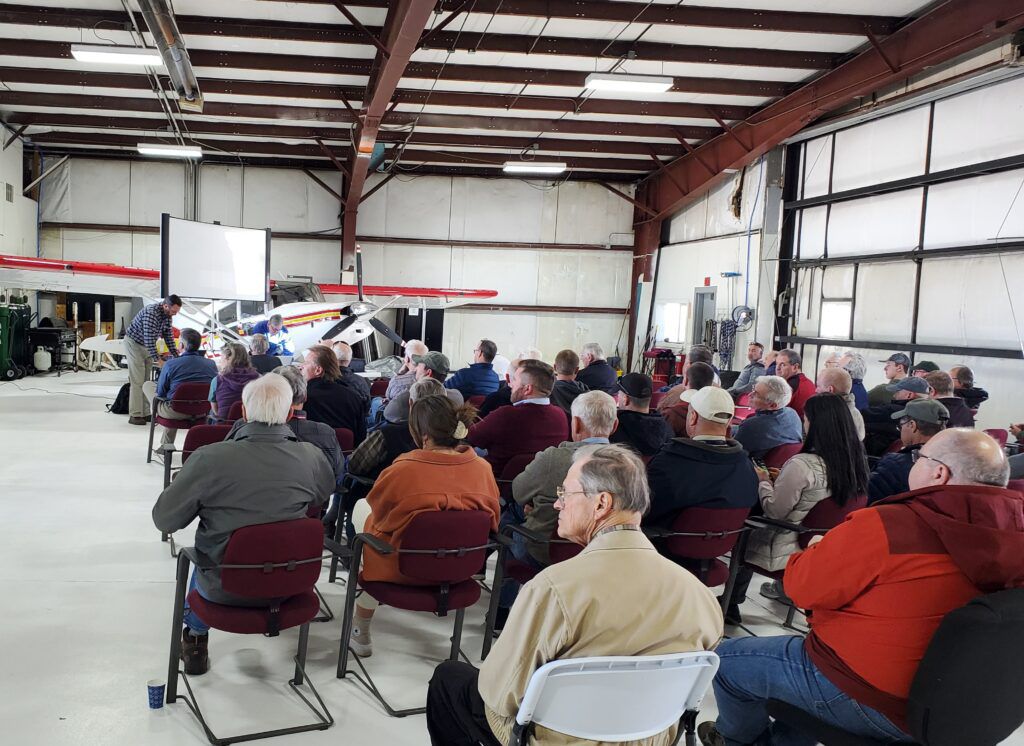New hangar report encourages displaced aircraft owners

LOVELAND – The findings of a new and more positive structural study of two previously condemned general-aviation hangar buildings at Northern Colorado Regional Airport mean some owners of private aircraft will have more time to keep their planes housed there — and additional analysis could mean they may not have to move at all for several years.
“What I heard was awfully encouraging,” airport commissioner Jerry Stooksbury told a standing-room-only audience at the panel’s regular Thursday meeting. “The sky’s not falling, nor are the buildings.”

The airport’s governing commission voted Thursday to extend the owners’ leases for two additional months in those “C” buildings — until Oct. 10 — and to commission a closer look at the two other, older “A” and “B” hangar buildings that also had been slated for demolition, although those structures’ eviction deadlines were left in place at June 10. But pilots expressed hope that the results of the new report would allow them to at least stay in the C buildings for several more years until new hangars could be built.
Scott Hargrove, a structural engineer at Centennial-based forensic engineering firm Knott Laboratory LLC, toured the two C hangar buildings on April 7 and told the airport’s governing commission on Thursday that “our findings are that the general health of the C hangars is satisfactory. They need repair, they need some maintenance, but at this point we do not see life-safety issues. With that said, there’s a caveat; if they’re not fixed, not maintained, they will become life-safety issues.”
Nearly four dozen owners of planes stored at the airport had suddenly faced eviction last month after commissioners received the findings of a report by Fort Collins-based Ditesco Project and Construction Services to identify the hangars’ useful lifespan for planning purposes. The panel emerged from a March 2 executive session with lawyers and risk managers from Fort Collins and Loveland, the cities who jointly own the airport, and declared that the eight-space A and 10-space B “T-hangar” buildings and the two 20-space C buildings posed safety and liability risks and would be “decommissioned” and razed. The owners of aircraft stored in the A and B buildings faced eviction by May 10 and those in the C buildings were told they had to be out by July 10.
However, the planes’ owners implored the panel at a March 9 town hall and at its regular March 16 meeting to give them and the cities time to do more detailed analyses, and won 30-day extensions of both eviction deadlines. The cities then hired Boise, Idaho-based Civil Innovations LLC and its subcontractor, Knott Laboratory, to do the new study.

Hargrove said his report, which the panel and the cities’ risk managers will review before its release to the pilots and public on Monday, noted that repairs to the C hangars, including tension rods, turnbuckles and anchors that keep the metal buildings standing during high winds could be repaired to extend those structures’ life. “On some of the columns, the anchor bolts don’t connect or there are no anchor bolts,” he said, but many of the fixes are “minor things” such as tightening of the turnbuckles and tension ties and replacing missing nuts.
According to the agenda packet for Thursday’s meeting, the cities planned to move forward with the decommissioning of the A and B buildings, and tenants of those buildings who are in compliance with their lease terms would be moved to the C buildings. A map included with the packet showed three vacancies in each of the two C buildings, plus a total of three tenants who are in violation of their lease terms. It showed four vacancies in the A building and five in the B building, plus one tenant in violation there.
The commission voted Thursday to give owners of aircraft stored in the A and B buildings priority in transferring to whatever hangars in the C buildings were available. With some owners already finding other homes for their planes and the Civil Air Patrol being offered space for its aircraft at Water Valley Land Co. CEO Martin Lind’s Discovery Air hangar, commissioners determined Thursday that it was possible all but two displaced A and B aircraft could find at least temporary homes in the C hangars.

The Knott Laboratory study was authorized after the pilots expressed frustration that the Ditesco report had made an assumption, based on spot checks of a few hangars, that all four buildings had to come down.
“It is our professional opinion,” the Ditesco report said, “that regardless of the condition of the remaining T-hangars, the condition witnessed in the inspected units is not salvageable and the structures are not candidates for retrofit. Based upon the observed condition of the T-hangars, it is our professional opinion that the T-hangars have met or exceeded their useful design life and additional analysis of the T-hangars will yield the same result.”
Loveland city engineer Nicole Hahn told the commission Thursday that the Ditesco report “was not a full scope, looking at every single hangar and really taking a deep dive into what the needs might be in order to extend the life. This scope looked very thoroughly at the structure and made recommendations.”
The next step, she said, is that “we will go in and do a full cost estimate, talk to our code department and see what things need to be brought up to code.”
Howard Abraham, who has been flying in the area for more than 50 years, said he hoped those code enforcers would realize that a simple hangar building “doesn’t have to have some of the amenities that planning commissions of the cities are charged with providing for human occupancy.”
Richard “Rick” Turley, who stores his Cessna 182 in one of the C hangars and has represented the displaced owners, explained that each of the structures in question is “one large open building, very easy and very inexpensive to assemble, built out of steel, sheathed in sheet metal, and then with separate doors for each one of the aircraft that are housed in the hangars.” He said they’re called T-hangars “because the planes sit back to back and overlap like the letter T.”

The aircraft owners remain frustrated that airport commissioners would not reveal whatever urgent concerns emerged during the March 2 executive session that prompted them to issue the sudden eviction orders, and, although grateful for the extensions, question why the panel allowed them if the safety and liability concerns were so pressing.
Stooksbury also urged revisiting the inspections of the A and B hangars and asked his commission colleagues to commit by their July 20 regular meeting to have the cost analysis completed about the recommended updates. Commission chairman Don Overcash, who also is Loveland’s mayor pro tem, and commission member Steve Adams, Loveland’s city manager, opposed further study of the A and B hangars on Thursday, referring to concerns over what they heard during the executive session and the panel’s unanimous vote that followed to decommission them that followed.
Stooksbury and a commission colleague, Fort Collins Mayor Jeni Arndt, said they wanted the Knott Laboratory report to be released immediately, but reached a compromise with Overcash and Adams that it would be made public Monday after the staff has had time to review it.
Turley, who also has implored the panel to let him in on the concerns raised at the executive session so that he could present more informed recommendations, told commissioners Thursday that solving “the liability aspect will come with maintenance.” He asked the panel Thursday to repeal the eviction notices entirely because it was “based on incorrect assumptions.”
The Ditesco report, he said, “was a study of economic life, not of safety,” and was “based on an assumption that all of the problems observed in the six sample hangars would apply to all hangars — and that’s simply not true. The observations in A and B do not apply to C.”
He acknowledged that “this commission went into closed session and appropriately considered risk in concert with risk management, and based on what we’ve seen, what we’ve observed, there is a risk. But those assumptions were flawed.

“If you had received Scott’s report instead of Ditesco’s report,” Turley told the panel, “you would have never made a motion — or if you’d made the motion, you probably wouldn’t have passed the motion — to evict the A, B and C owners.
“You now have sufficient data to show that’s true,” Turley told the panel. Although he said he appreciated the further two-month extension for C-hangar tenants like himself, “I don’t want to have to keep coming back here every month, fighting this battle day after day after day.”
Turley said that whatever the needed repairs were, the airport could afford to make them.
“Over a four-year period,” he said, “there is a net value from the rent we pay for our hangars, based on the financial reports from the airport, of more than $600,000. That’s based on revenues minus expenses. That money has been collected. The money is there to provide repairs, and I don’t think it’s going to be a $600,000 repair. In addition, I understand there’s at least a $3 million net position available in the bank for the airport, so the cash is there” for airport management to pay for the repairs.”
Turley said the owners realize “the T-hangars will ultimately need to come down” as part of the airport’s long-range plan. “We know we need a new home. As pilots, we want to engage in getting a new location, a new T-hangar solution.” The airport master plan has designated a place for that construction, he said, but it’s “at least two years away from that site being shovel ready. Please don’t tear down and put us in this position again until that site is ready and a building plan has been approved.”
Turley wasn’t overly hopeful that new studies would produce very good news for the A or B buildings. He said “one engineer who I walked through A and B with said ‘I can fix these. I don’t see what the problem is.’ I’ve had others say, ‘Good thing you’re not looking at A and B.’”
However, Stooksbury noted that if the two remaining A and B owners could accept the risk, “then we have 18 more hangars available.”
Speaking to the aircraft owners at a meeting earlier in the day at Lind’s Discovery Air hangar, Brad Schuster, the Seattle-based regional manager for the Aircraft Owners and Pilots Association, said his seven-state organization is “hyper-focused on the erosion of hangar space nationwide,” that finding new space in a shrinking market often means “going from a car payment to a house payment” for aircraft owners, and urged that federal funds be earmarked for general-aviation airports to defray some of the costs.

Schuster heard from the crowd of aircraft owners about what they perceived as the Loveland-Fort Collins airport’s lack of transparency and its intention to eventually crowd general aviation out.
“We’re the low man on the totem pole,” said Pam Busboom, who said she and her husband have stored their single-engine Piper Archer at Northern Colorado Regional Airport for 20 years. “What’s happening in A, B and C is coming for the rest of the hangars too because of the way they’re renegotiating leases. I don’t think we’ve got the commission’s attention. They just want us to go away and put the big jets in and the corporate pilots in.”
And there’s nowhere to go, she said, noting that “you just can’t find hangars” and that Rocky Mountain Metropolitan Airport in Broomfield, for instance, has had a waiting list since 2012. The Northern Colorado airport had told the tenants facing eviction that they could tie their planes down outdoors, but Busboom said that with Colorado’s “wind, sun, rain and hail, you can’t leave an airplane on the ramp.”
Even more than hangar space, she said, “safety is our biggest concern.”
Between the airport’s mobile control center, which pilots call the “horse trailer,” and the Federal Aviation Administration’s experimental remote control tower, she said, “they don’t have radar. They have binoculars.”
About all the issues, she said, “we can scream and yell all we want,” but that nothing was likely to happen “unless we get some ravenous attorneys on our side.”
Lind brought some attorneys with him to both meetings Thursday — representatives of Denver-based Recht Kornfeld PC — and said “I’ve tried to do it the kind way. It’s easier to gather bees with honey than with a fly swatter, but sometimes you need to use a fly swatter. We need to start shining the sunlight of transparency, and if it takes litigation to do that, that’s what it’s going to be.”
Lind delivered a seven-page letter to the commissioners from attorney Michael D. Plachy at Denver-based Lewis Roca Rothgerber Christie LLP in which Plachy contended that the airport is in violation of federal law because, “as a past and prospective recipient of federal funding, it is prohibited from granting preferential treatment or special rights to any airport user, including any fixed-base operator. The airport violates these prohibitions by granting preferential treatment and exclusive rights to jetCenters of Colorado.” Plachy wrote that “such disparate treatment gives a windfall to jetCenters” at the expense of its competition including Lind’s Discovery Air.
At the earlier meeting at Discovery Air, Lind urged the assembled aircraft owners, “If you guys and ladies don’t band together and circle up, you’re out. But you don’t need to be pushed out. You’ve paid the bills. You’ve earned the right.
“Not only are the C hangars very capable of staying in existence for numerous decades,” Lind said, “but my companies investigated A and B hangars and, yeah, they’re ratty and ugly, but our contractor felt very comfortable that we could rebuild them, make them beautiful.”
Lind echoed Busboom’s concern about safety, especially with thousands of operations including student pilots using the airport.
“That’s the elephant in the room,” he said. “To me, it’s maddening as a taxpayer and stakeholder, and frightening as a pilot.”
Source: BizWest



